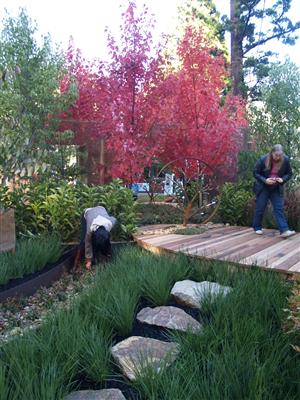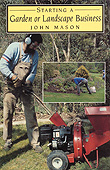Garden Steps
A step consists of two main parts:
- The riser: the vertical part (ie. the height), and
- The tread: the part you tread on (ie. the horizontal section).

The riser and tread always need to bear a comfortable relationship to each other, otherwise the step becomes difficult to walk up (e.g. If the tread is very narrow and the riser very high, the step becomes difficult to use).
STEP CONSTRUCTION
-
Always use a non slip material.
-
Remember, though wood and stone might be non slip, if it is not used a lot, and if it becomes very wet, moss or algae can grow on the surface making it slippery.
-
If the step is in a place which might frequently be wet, and there is a chance it might become slippery at times, install a hand rail.
-
Pay attention to drainage. The faster steps drain, the quicker they become dry. A slight slope to the side is important usually to remove water from the steps (do not slope to the front, this just redirects water to the next step down).
MATERIALS
Wood - Can be used, but generally only for the riser. If wood is used for a tread, be cautious of it becoming slipper. Frost on a wood step can be particularly dangerous. If wood is used for a riser, concrete, asphalt or gravel might be used for the tread. This may be inexpensive and adequate in a home garden, but not in a public garden.
Concrete - Concrete is easy to work with and excellent for steps. Do not have a perfectly smooth tread though; tradesmen usually put some type of indentations into the surface of each step to give a better grip.
Bricks or Pavers - These can be excellent, but once again, pay attention to the grip. If set into concrete, there should be no maintenance problem, however, without concrete or cement, there can be two problems:
Asphalt - An ideal material for the tread, normally used in conjunction with stone, brick or timber risers.
Cut Stone - Cut stone such as slate can be used to great effect for steps. You need once again to check that the stone is not so smooth and likely to be slippery.
|
Want To Start A Landscape Business? Read John Mason's Book
 click to buy click to buy
|
STUDY LANDSCAPE CONSTRUCTION or
GARDEN DESIGN Click to see our Landscaping Courses
These courses have been developed, and are taught by a team of more than a dozen professional landscapers and horticulturists, from both Australia and the UK, including several award winning designers.
|
Want to Learn More?
Check out horticultural and landscaping publications in the ACS Bookshop: http://www.acsbookshop.com/
For more information on Courses on all Landscaping, Horticulture and Plants:
In Australia: http://www.acs.edu.au/Courses/horti.aspx
In the UK: http://www.acsedu.co.uk/Courses/horti.aspx
You may also be interested in....